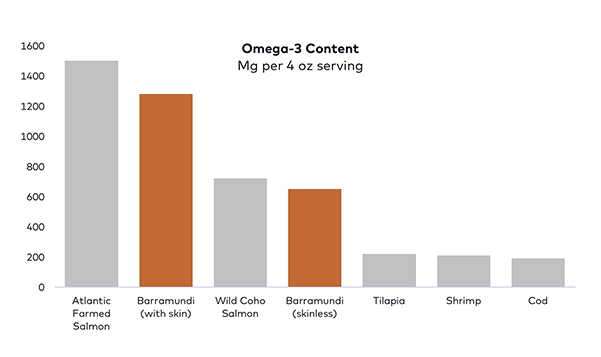Your Brain on Omega-3s

The positive benefits of omega-3 fatty acids on our cardiovascular systems are well-known. It turns out that this essential nutrient is vital for brain health, too.
Consisting of 60 percent fat, the brain needs omega-3s to properly develop and function. Researchers have discovered that omega-3 fatty acids are some of the most critical, most influential molecules on your brain’s integrity and ability to perform.
The ways in which omega-3 fatty acids help our brains and nervous systems include:
- Preserves cell membrane health
- Facilitates communication between neurons
- Assists in the synthesis and function of neurotransmitters
- Supports brain blood flow
- Aids in the growth of brain tissue
- Supports cognition, including memory
- May prevent neuropsychiatric and neurodegenerative disorders including depression and anxiety
Because humans lack the enzymes needed to create omega-3s, the only way we can get these fatty acids to optimize our brain health is through our diet. Throughout the rest of this article we explore the role omega-3s play in brain development and performance, and where you can find the best sources of omega-3s for optimal health and wellness.
Recap
Omega-3s play a vital role in cell health and communication, development of brain tissue, better sleep and cognition, and preventing both neuropsychiatric and neurodegenerative diseases. Because our bodies can’t make omega-3s, it’s essential that we get them through our diet.
Why Your Brain Needs Omega-3s
The three omega-3s found in our food are alpha-linolenic acid (ALA), eicosapentaenoic acid (EPA) and docosahexaenoic acid (DHA). Both DHA and EPA are critical for optimal brain health. DHA is the most abundant fatty acid in the brain and is especially important in nerve cell structure and function.1, 5
EPA plays an important role in the regulation of cellular inflammation.2 Both DHA and EPA determine how well the brain develops, how well the brain functions, and how well the brain is preserved as it ages.
Our levels of DHA change depending on the type and amount of fatty acids in our diet, and both DHA and EPA levels naturally decrease as we age.3 We can get DHA and EPA either by consuming the fatty acids themselves, or by ingesting ALA, which the body metabolizes into DHA and EPA.
While we are capable of converting ALA into DHA and EPA, it is not a very efficient process and the conversion rate is low.
Adequate levels of DHA make it easier, quicker, and more effective for nerve cells to communicate. Fatty acids make up the outer membrane of nerve cells, as well as, the myelin sheath, the protective casing that surrounds our nerves.4 Damage to the myelin sheath can result in symptoms of vision loss, muscle weakness, muscle spasms, loss of coordination, and diseases like Multiple Sclerosis. Omega-3s can aid in the regrowth of the myelin sheath and even restore nerve function in some cases.5
Omega-3 fatty acids are also necessary for healthy brain and eye development in utero, postnatal, and into early childhood. Most brain growth is complete by the age of six so that is an especially critical time to ensure your child is getting enough DHA and EPA from their diet. Studies have shown that greater fish consumption is associated with improved cognition among children. Recent research reports that frequent fish intake was related to fewer sleep problems in children and higher IQ scores.
Recap
There are three types of omega-3s—ALA, EPA and DHA. DHA and EPA play a key role in brain structure, communication, and protection. They are essential for proper brain development in fetuses, babies, and toddlers, and impact brain function throughout adolescence and adulthood. They also protect against cognitive decline and dementia later in life.
How Omega-3s Protect Your Brain From Neurological Conditions
An imbalance of omega-3s in your diet can lead to not only impaired brain performance but also disease. These essential fatty acids have been shown to prevent and improve several neurological conditions, including depression, bipolar disorder, anxiety, ADHD, Alzheimer’s disease, and dementia.
While many factors may contribute to depression, an imbalance in the neurotransmitters serotonin and dopamine are linked to this disorder. Increasing omega-3 consumption could be beneficial in the treatment of depression due to its potential in enhancing regulation of serotonin and dopamine transmission.7 Omega-3s are also capable of decreasing inflammation in the brain, a major factor involved in depression.
Omega 3s can also help reduce the development and symptoms of anxiety. Studies even show that adequate levels of EPA are associated with protection against post-traumatic stress disorder (PTSD)!8
As we age, our brain goes through many physical and biological changes including shrinkage in volume, a loss of plasticity, and a decrease in omega-3 levels, which could contribute to overall cognitive decline. Omega-3s reduce neuroinflammation and oxidative damage which reduce the production of amyloid-β plaques in the brain. Omega-3s also increase levels of brain-derived neurotrophic factor, also known as BDNF, and improve insulin signaling. All of these positive effects are linked to decreased risk for both the development and progression of dementia and Alzheimer’s Disease.9, 10
Adequate levels of omega-3s also support proper blood flow in the brain. Brain imaging studies show that higher blood flow in certain parts of the brain are associated with better performance for various cognitive tasks. Proper blood flow also supports memory and decreases the risk of developing dementia.11
Findings from a recent study found that the consumption of seafood and omega-3s reduces age-related cognitive deterioration, specifically in subjects’ ability to remember facts and to learn and process new information. The study demonstrated that older adults without dementia who ate one or more servings of seafood per week have less cognitive decline than those who eat less than one serving of seafood per week.
Recap
Omega-3s may also help prevent or ease depression, bipolar disorder, anxiety, ADHD, Alzheimer’s, and dementia; as well as reduce age-related cognitive decline (including memory and the ability to learn and process new information).

Where to Find the Best Sources of Omega-3s
The healthiest choices for omega-3 fatty acids include fish that are rich in DHA and EPA, such as barramundi, salmon, trout and sardines; with farmed barramundi having the highest ratio of omega-3 to total fat, at 25 percent. (Barramundi also has the highest level of omega-3 fatty acids—960mg per 6 oz skinless serving*—of any commonly eaten white fish.)
While you can also get DHA and EPA from fish oil supplements (like fish oil), studies have shown that fatty acids from fish are more effectively absorbed into our system than when taken as a supplement.12 One reason for the better absorption may be due to the synergistic effect of various nutrients in fish, rather than just taking the omega-3s alone.
Vegetable oils, flaxseeds, walnuts and dark leafy vegetables are all sources of the ALA type of omega-3s, but our bodies can only turn small quantities of it into EPA and DHA, and therefore it doesn’t provide as many omega-3s as fish does.
Recap
Fatty fish, such as salmon, trout, sardines and barramundi, are the best and most efficient way to get your omega-3s. Plant sources of omega-3s include vegetable oils, flaxseed, walnuts, and dark leafy vegetables in the form of ALA, but our body isn’t efficient at converting these ALA fats into the beneficial DHA and EPA omega-3 fatty acids.
About Taylor Stolt RDN, LD, CLT
Taylor Stolt is a Functional Medicine Dietitian who specializes in gut health, hormones, inflammatory conditions, and detoxification.
Sources
- Essential fatty acids and human brain. Chang, CY, Ke, DS, and Chen, JY. Acta Neurologica Taiwanica, 2009 Dec;18(4):231-41 https://www.ncbi.nlm.nih.gov/pubmed/20329590
- Rapid beta-oxidation of eicosapentaenoic acid in mouse brain: an in situ study. Prostaglandins Leukot Essent Fatty Acids. 2009;80(2-3):157-163. doi:10.1016/j.plefa.2009.01.005
- The role for dietary omega-3 fatty acids supplementation in older adults. Nutrients. 2014;6(10):4058-4073. Published 2014 Oct 3. doi:10.3390/nu6104058
- Siegert E, Paul F, Rothe M, Weylandt KH. The effect of omega-3 fatty acids on central nervous system remyelination in fat-1 mice. BMC Neurosci. 2017;18(1):19. Published 2017 Jan 24. doi:10.1186/s12868-016-0312-5
- https://www.mayoclinic.org/diseases-conditions/multiple-sclerosis/expert-answers/demyelinating-disease/faq-20058521
- The mediating role of sleep in the fish consumption – cognitive functioning relationship: a cohort study. Liu, J, et al. Scientific Reports 7, Article number: 17961(2017) doi:10.1038/s41598-017-17520-w
- Omega-3 Fatty Acids and Depression: Scientific Evidence and Biological Mechanisms. Grosso, G. Oxid Med Cell Longev. 2014; 2014: 313570.Published online 2014 Mar 18. doi:10.1155/2014/313570
- Association of Use of Omega-3 Polyunsaturated Fatty Acids With Changes in Severity of Anxiety Symptoms
- DHA may prevent age-related dementia. J Nutr. 2010;140(4):869-874. doi:10.3945/jn.109.113910
- APOE ε4 and the associations of seafood and long-chain omega-3 fatty acids with cognitive decline van de Rest, O., et al. Neurology May 2016, 86 (22) 2063-2070; DOI:10.1212/WNL.0000000000002719
- Quantitative Erythrocyte Omega-3 EPA Plus DHA Levels are Related to Higher Regional Cerebral Blood Flow on Brain SPECT. J Alzheimers Dis. 2017;58(4):1189-1199. doi:10.3233/JAD-170281
- Dietary intake of fish vs. formulations leads to higher plasma concentrations of n-3 fatty acids. Visioli, F, et al. Lipids. 2003; Apr;38(4):415-8